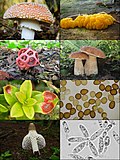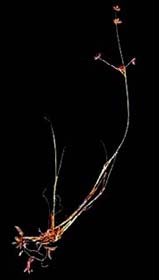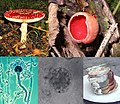Dikarya is a subkingdom of Fungi that includes the divisions Ascomycota and Basidiomycota, both of which in general produce dikaryons, may be filamentous...
7 KB (514 words) - 23:03, 22 June 2024
and with unstacked Golgi apparatus cisternae. Members of this clade are Dikarya and the traditional paraphyletic assemblage "Zygomycota", now divided into...
7 KB (277 words) - 10:26, 1 December 2023
with the characteristic hyphal growth, Zoopagomycota, Mucoromycotina and Dikarya, originated from a common ancestor ~700 Mya. Zoopagomycota are mostly pathogens...
11 KB (876 words) - 08:44, 18 May 2024
Symbiomycota is a clade of fungi containing both Glomeromycota and Dikarya. It is supported with RNA analysis. It includes all Mycorrhiza hence the name...
4 KB (237 words) - 09:45, 13 August 2023
sole class in the phylum Entorrhizomycota, within the Fungi subkingdom Dikarya along with Basidiomycota and Ascomycota. It contains three genera and is...
11 KB (1,105 words) - 18:52, 1 February 2024
divisions that, together with the Ascomycota, constitute the subkingdom Dikarya (often referred to as the "higher fungi") within the kingdom Fungi. Members...
31 KB (3,283 words) - 03:23, 28 June 2024
the Basidiomycota—are contained within a branch representing subkingdom Dikarya, the most species rich and familiar group, including all the mushrooms...
201 KB (19,177 words) - 01:12, 28 July 2024
formation of a dikaryon is a plesiomorphic character for the subkingdom Dikarya, which consists of the Basidiomycota and the Ascomycota. The formation...
3 KB (285 words) - 15:24, 23 July 2023
Fungi of Australia (section Non-Dikarya)
Apart from fungi of the subkingdom Dikarya, such as those described above (Ascomycota and Basidiomycota), some non-Dikarya fungi are known to have relatively...
22 KB (2,585 words) - 08:09, 2 August 2024
Blastocladiomycota Chytridiomycota Glomeromycota Microsporidia Neocallimastigomycota Dikarya (inc. Deuteromycota) Ascomycota Pezizomycotina Saccharomycotina Taphrinomycotina...
11 KB (767 words) - 16:50, 20 July 2024
kingdom Fungi that, together with the Basidiomycota, forms the subkingdom Dikarya. Its members are commonly known as the sac fungi or ascomycetes. It is...
54 KB (6,636 words) - 15:13, 17 July 2024
including the common bread molds Mucor and Rhizopus. It is a sister phylum to Dikarya. Informally known as zygomycetes I, Mucoromycota includes Mucoromycotina...
14 KB (1,578 words) - 03:35, 17 June 2024
Ascomycota and Basidiomycota (the two divisions of the fungus subkingdom Dikarya) 0.97 Ga. The paper's authors state that their time estimates disagree...
72 KB (8,149 words) - 15:52, 10 July 2024
Zoosporic fungi (paraphyletic) Zygomycota (paraphyletic) Dikarya...
11 KB (1,052 words) - 06:40, 16 May 2024
Zoosporic fungi (paraphyletic) Zygomycota (paraphyletic) Dikarya...
23 KB (1,925 words) - 00:49, 14 May 2024
Zoosporic fungi (paraphyletic) Zygomycota (paraphyletic) Dikarya...
3 KB (230 words) - 15:26, 2 July 2024
fusions with non-self. Heterokaryosis is also common upon mating, as in Dikarya (Ascomycota and Basidiomycota). Mating requires the encounter of two haploid...
5 KB (670 words) - 17:46, 3 December 2023
Zoosporic fungi (paraphyletic) Zygomycota (paraphyletic) Dikarya...
23 KB (2,898 words) - 13:04, 26 July 2024
2017. Lineage( full ) cellular organisms; Eukaryota; Opisthokonta; Fungi; Dikarya; Ascomycota; saccharomyceta; Pezizomycotina; Pezizomycetes; Pezizales;...
6 KB (582 words) - 11:46, 1 July 2024
surrounding envelope. 200 μm long. Scientific classification Kingdom: Fungi Subkingdom: Dikarya Genus: Tortotubus Johnson, 1985 Species T. protuberans...
8 KB (842 words) - 02:30, 26 October 2023
Zoosporic fungi (paraphyletic) Zygomycota (paraphyletic) Dikarya...
22 KB (1,621 words) - 02:35, 21 May 2024
Zoosporic fungi (paraphyletic) Zygomycota (paraphyletic) Dikarya...
15 KB (1,617 words) - 19:58, 14 July 2024
Zoosporic fungi (paraphyletic) Zygomycota (paraphyletic) Dikarya...
20 KB (2,031 words) - 12:59, 28 July 2024
found through molecular sequencing data, to be a closer relation to the Dikarya. Their fossil record extends back to the Ordovician period (460 million...
4 KB (331 words) - 01:42, 3 April 2024
beneath the apical plasma membrane. This structure is most commonly found in Dikarya and was at first thought to only occur among them. Vargas et al 1993 however...
7 KB (685 words) - 10:26, 19 April 2024
Zoosporic fungi (paraphyletic) Zygomycota (paraphyletic) Dikarya...
30 KB (2,803 words) - 17:09, 3 August 2024
cerato-platanin, which occurs in the cell wall of C. platani, as well as other Dikarya, and is involved in molecular fungus-host interactions. Oriental plane...
6 KB (630 words) - 20:44, 13 January 2024
Zoosporic fungi (paraphyletic) Zygomycota (paraphyletic) Dikarya...
6 KB (605 words) - 21:31, 5 August 2024
(SSU) rRNA sequences indicated that they share a common ancestor with the Dikarya. Nowadays it is accepted that Glomeromycota consists of 4 orders. Several...
19 KB (2,016 words) - 11:35, 21 May 2024























